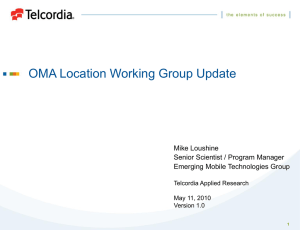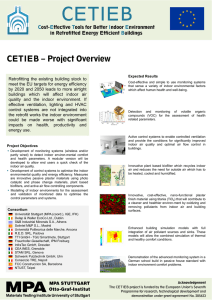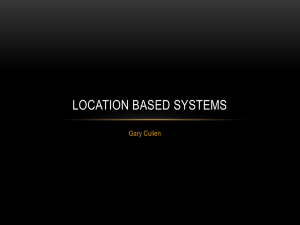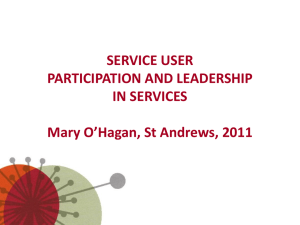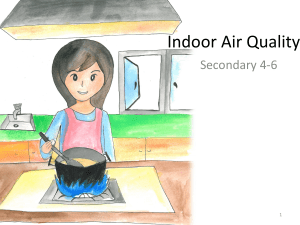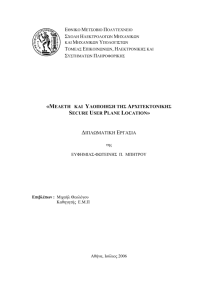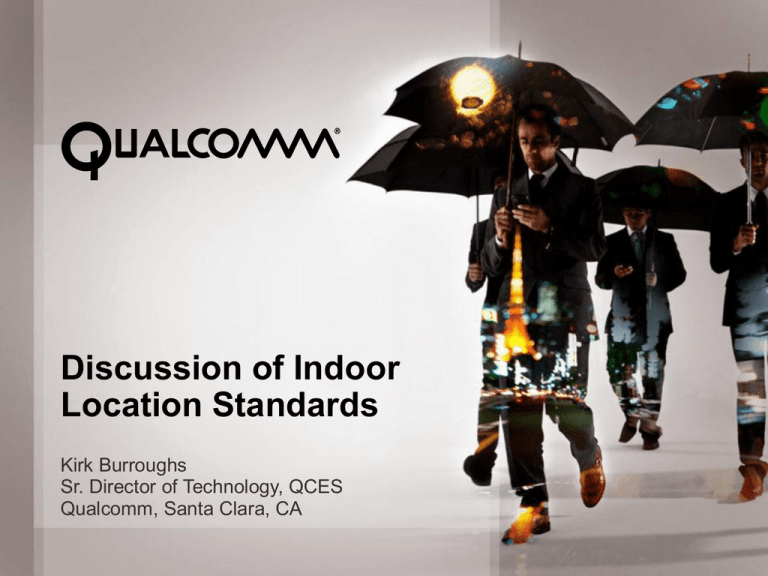
Discussion of Indoor
Location Standards
Kirk Burroughs
Sr. Director of Technology, QCES
Qualcomm, Santa Clara, CA
© 2012 QUALCOMM Incorporated. All rights reserved.
1
Summary of Standards Activities (1/2)
3GPP /
3GPP2
OMA
•
•
•
•
LTE OTDOA rolling out soon (AFLT been in place for ~10 years)
Compass Standardization will hopefully start soon
Femtocell solutions generally lack explicit location support
Ramp up of WLAN related work (e.g. data offloading) that is also generally not
concerned about location impacts
•
•
SUPL 1.0 and 2.0 User Plane versions of 3GPP/3GPP2 Standards
SUPL 3.0 and LPPe 1.0 just published and includes indoor positioning related
requirements
Work on LPPe v1.1 started recently and will add broadcast capabilities to LPPe
•
IEEE
802.11v
• Allows for location related information to be transmitted at the WLAN layer
802.11u
• Enables Service Discovery
IETF
•
•
•
Working on spec for passing WLAN information (802.11v based)
Civic Address
extensions
for indoor locals
Blah,
blah, blah
Relative Location with reference to a map document
© 2012 QUALCOMM Incorporated. All rights reserved.
2
Summary of Standards Activities (2/2)
FCC
TTA
Worldwide Web
Consortium
(W3C)
Open Geospatial
Consortium
(OGC)
Femto
Forum
•
•
•
•
CSRIC WG3 is working on three reports:
Outdoor location accuracy testing
Indoor location accuracy testing
Leveraging commercial location based services (e.g., WLAN positioning) for E911
•
•
•
Several activities ongoing related to WLAN based indoor location
RTT ranging – client / server signaling, RSSI between APs
Wi-Fi AP DB Data Sharing Interface
•
•
Geo-location API has achieved widespread browser implementation
Published a first draft of a technical specification for the representation of "Points
of Interest" information on the Web
Device Orientation specification in Last Call stage and an implementation exists
in Android Ice Cream
Sandwich
Blah,
blah, blah
•
•
Indooor GML SWG just formed which is working on a standard for representing
navigation routes, etc
•
•
Published White Paper on “Femtocell Synchronization and Location”
Develops “Rich Location API”
© 2012 QUALCOMM Incorporated. All rights reserved.
3
Open Mobile Alliance (OMA) – SUPL and LPPe
OMA introduced support for indoor navigation in its recent Enablers
Secure User Plane Location (SUPL 3.0) and LTE Positioning Protocol
Extensions (LPPe 1.0)
The goal of SUPL 3.0 and LPPe 1.0 are to improve the user
experience through better service and new features, specifically
including, improved Indoor Location Accuracy
Addresses the special requirements arising from indoor location issues
An example of such is the support for floor level information as well as the use of
relative instead of global coordinates
The building blocks for indoor navigation support in OMA are:
Decentralized Location Server (D-SLP: Discovered SUPL Location Platform) for
Assistance Data Delivery and Position Calculation.
Positioning Protocol supporting indoor navigation relevant assistance data (map
information, AP information, etc.).
D-SLP is part of SUPL 3.0 and the positioning protocol supporting indoor navigation is
LPPe 1.0.
© 2012 QUALCOMM Incorporated. All rights reserved.
4
OMA SUPL Network Architecture for Indoor Positioning
• It is assumed that the H-SLP cannot provide
adequate support for Indoor Positioning and
therefore public venues (malls, hospitals, train
stations, etc.) may choose to provide their own
Indoor Positioning Location Server (D-SLP).
• The SET discovers a local SLP (D-SLP) which is
able to provide Indoor Positioning service within a
defined service area (e.g. a shopping mall).
• The SET requests authorization for accessing the
D-SLP from its H-SLP.
• The H-SLP authorizes access within a defined
service area, access network, and time window.
• While the SET is within the service area, time
window and the authorized access network of the
D-SLP, it may access the D-SLP and obtain Indoor
Positioning Services.
• The Signaling between D-SLP and H-SLP uses
OMA SUPL ULP.
SET: SUPL Enabled Terminal
H-SLP: Home SUPL Location Platform
D-SLP: Discovered SUPL Location Platform
© 2012 QUALCOMM Incorporated. All rights reserved.
• Indoor Positioning signaling is carried within OMA
SUPL ULP message containers in OMA LPPe
messages.
• The D-SLP discovery mechanism is out of scope5 of
IEEE 802.11v
Wireless Network Management (WNM) standard for the IEEE 802.11 family
of standards
Enables management of stations in a centralized or in a distributed fashion (e.g.
monitoring, configuring, and updating) through a layer 2 mechanism
The WNM services include (among others) Location Services:
Request/Response paradigm
Location Configuration Request and Response frames enable STA’s to configure a
collection of location related parameters for Location Track Notification frames
The AP can indicate that it can provide location data to support applications such as
emergency services
Location Services also provide the ability for STAs to exchange location information
using Radio Measurement Request and Response frames
The protocol supports exchange-by-value and exchange-by-reference mechanisms
The location value can be exchanged in Geospatial and Civic formats
© 2012 QUALCOMM Incorporated. All rights reserved.
6
IEEE 802.11v
802.11v supports basic location measurements for
Cell-ID (AP Location)
Signal Strength
Time-Based Methods (i.e. T(D)OA)
Components in 802.11v to support Location Services
Radio Measurement Request/Response frames (extended from 802.11k)
Types:
» Local: “Where am I?”
» Remote: “Where are You?”
» 3rd Party: “Where is He/She?”
Location Value: Geodetic, civic (reference point with relative location and map image), or location
reference (URI)
Location Configuration Request/Response frames
Provides the ability to configures a STA for (subsequently) sending Location Track Notification
frames for the purpose of tracking the receiving STA’s location
Upon successful configuration, the receiving STA starts transmitting Location Track Notification
frames based on the Location Configuration Request frame parameters
Location Track Notification frame
Reports various radio/location related parameters
» Transmit Power, Antenna Gain, Received Signal to Noise Indicator (RSNI), Received Channel
Power Indicator (RSCPI), Velocity, Time of Departure (TOD), Beacon Measurement Report
© 2012 QUALCOMM Incorporated. All rights reserved.
7
Internet Engineering Task Force (IETF) – GEOPRIV (1/2)
GEOGRAPHIC LOCATION/PRIVACY (GEOPRIV) WORKING GROUP
Handles protocols and standards for location determination, provisioning, and
disclosure.
For determination, the specifications provide information to be used to determine location, but in
general don’t describe how the information is used to do so.
Originally limited to location distribution but expanded to include assistance data and client-side
measurements for server-based location determination, as well as other extensions.
Also working on relative location (used for indoor location), civic address extensions, and various
other issues.
Does not develop location-determining technology; however, develops protocols/extensions to
represent and transmit data used to determination location
RFC 5139 - REVISED CIVIC LOCATION FORMAT FOR PRESENCE
INFORMATION DATA FORMAT LOCATION OBJECT (PIDF-LO)
Defines XML format for representation of civic location
» Updates the civic location format in RFC 4119 to include in-building information (apartment,
room, seat (desk, cubicle, workstation))
RFC4119 provides a way to specify an addressable civic location, naming the country,
region, city, street name, etc.
Format to be supported in SUPL 3.0
© 2012 QUALCOMM Incorporated. All rights reserved.
8
Internet Engineering Task Force (IETF) – GEOPRIV (2/2)
[draft-rosen-geopriv-pidf-interior-01] Interior Location in the Presence
Information Data Format – Location Object
Related to RFC 5139, and defines explicit tags for interior building location such as "BLD"
(building), "UNIT", "ROOM“
An example of where the RFC 5139 BLD/FLR/UNIT/ROOM doesn't work is an airport. Interior location
may be given as Terminal 2, Concourse A, Gate 27
draft-ietf-geopriv-held-measurements-01 - Using Device-provided LocationRelated Measurements in Location Configuration Protocols
Allows device and server to exchange data useful for location determination, e.g., device
measurements, GNSS assistance
Defines request/provide location-related measurement data to a Location Information Server (LIS)
Includes (among others) 802.11 WLAN measurements (similar to SUPL 2.0 ULP):
» location of the access point, flight time, transmit power, rcpi (received channel power indicator), rsni
(received signal to noise indicator)
» Updates to WiFi measurement structure (based on 802.11v)
[draft-ietf-geopriv-relative-location-00] Relative Location Representation
Extends PIDF-LO for the expression of location information that is defined relative to a
reference point (which is expressed with a civic or geodetic representation)
Offset is expressed in meters and a directional vector
Can include an URI to a document that can contain a map/floorplan/illustration ('map') upon which the
relative location can be plotted
» Maps can be simple images, vector files, 2-D or 3-D geospatial databases, or any other form of
representation understood by both the sender and recipient
© 2012 QUALCOMM Incorporated. All rights reserved.
9
Wrap-Up
3GPP/3GPP2 have addressed satellite and terrestrial positioning of the mobile
user but without the stated goals for indoor vs outdoor per se, very high
accuracies, or specific indoor related aspects
And while AFLT and the soon to be launched OTDOA, as well as A-GNSS, most certainly
can provide position estimates for users indoors, not all use cases can be addressed with
the current accuracy levels
3GPP/3GPP2 have arguably neglected fully leveraging femto cells and WLAN interworking
as a cornerstone for a broader standards based positioning solution
Over the past many years a multitude of disjoint standardization efforts targeting
indoor positioning and navigation have occurred
WLAN ranging, extended reference systems, relative positioning, etc
OMA is starting to define a reasonably complete solution, especially for WLAN
based solutions
Probably the best standard organization to allow for all the necessary standardization for
the indoor location ecosystem to avoid fragmentation as it evolves
Qualcomm recommends that 3GPP, 3GPP2, OMA, IETF, IEEE, et al and the
member companies cooperate at a the requirements and systems level to avoid
fragmentation of the indoor location ecosystem
© 2012 QUALCOMM Incorporated. All rights reserved.
10
©2012 Qualcomm Incorporated. All rights reserved. Qualcomm is registered trademark of Qualcomm
Incorporated. All the trademarks or brands in this document are registered by their respective owner.
QUALCOMM Incorporated, 5775 Morehouse Drive, San Diego, CA 92121-1714
© 2012 QUALCOMM Incorporated. All rights reserved.
11

